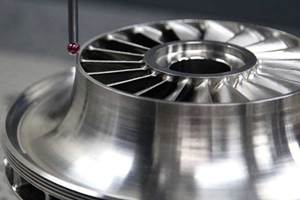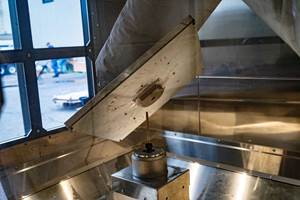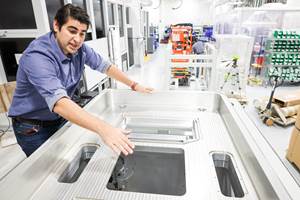Spee3D Successfully Tests Metal AM System During DOD’s Rim of the Pacific Exercise
Spee3D’s Expeditionary Manufacturing Unit (EMU) printed 11 metal parts for repair and replacement of defense equipment in a contested environment to prove that AM can help secure military supply chains by reducing the delivery time of critical parts from days to hours and at the point of need.
Spee3D’s Expeditionary Manufacturing Unit (EMU) is a complete on-site mobile additive manufacturing solution. Source: Spee3D
Spee3D, a metal additive manufacturing (AM) company, has successfully completed the Trident Warrior experimental portion of the Rim of the Pacific (RIMPAC) exercise at the Marine Corps Air Station in Kaneohe Bay, Hawaii. Spee3D deployed its Expeditionary Manufacturing Unit (EMU), a complete on-site mobile additive manufacturing (AM) solution, to print 11 cast-equivalent metal parts from aluminum and stainless steel to be studied for their material properties and viability for repairing and replacing defense equipment in a contested environment.
RIMPAC is the world’s largest international maritime exercise. Within it, Trident Warrior focuses on testing cutting-edge technologies, including AM. A team of engineers from the Consortium for Advanced Manufacturing Research and Education (CAMRE) printed cast-equivalent replacement metal parts using the EMU for the Army, Navy and Air Force, Marine and Coast Guard. The goal of implementing Spee3D’s proprietary cold spray additive manufacturing (CSAM) solution was to prove that AM can help secure military supply chains by reducing the delivery time of critical parts from days to hours and at the point of need.
“SPEE3D is thrilled to be included in RIMPAC, the largest distributed advanced manufacturing demonstration the Department of Defense has ever conducted to date,” says Byron Kennedy, Spee3D CEO. “In particular, additive manufacturing has been a major area of interest for the Department of Defense, and together we have the same goals to train the military and implement additive manufacturing to print crucial metal parts at the point of need to support modernization and warfighter readiness.”
The XSpee3D expeditionary metal 3D printer features the Spee3Dcell postprocessing and testing unit, which together can produce cast-equivalent metal parts in hours instead of days or weeks, thereby minimizing the cost of disruption and downtime. The system includes two 20-foot containers with twist locks; a rugged, mobile metal 3D printer that can produce high-density metal parts in a wide range of materials; and a fully equipped postprocessing shop, including a heat treatment furnace, CNC three-axis mill, tooling and testing equipment. The mobile EMU can be transported on a single platform in a truck trailer, ship or plane.
“CAMRE facilitates getting the latest in advanced manufacturing into operational settings and finds ways to unlock additional capabilities,” says Lt. Col. Michael Radigan, a member of the Marine Innovation Unit and the government lead on the CAMRE team for Trident Warrior 24. “Spee3D worked side-by-side with our joint participants to further research on cold spray additive manufacturing and helped us uncover best practices to apply its unique capabilities in expeditionary environments.”
RIMPAC and Trident Warrior included approximately 29 nations, 40 surface ships, three submarines, 14 national land forces, more than 150 aircraft and more than 25,000 personnel trained and operating in and around the Hawaiian Islands during the exercise. The events provided a unique training opportunity while fostering and sustaining cooperative relationships among participants.
The CAMRE at the Naval Postgraduate School is focused on accelerating the adoption of advanced manufacturing for the joint force. Through cutting-edge research and validation of operating concepts during military exercises, CAMRE provides expert knowledge to warfighters on how to successfully implement advanced manufacturing in contested environments.
Related Content
Velo3D Founder on the 3 Biggest Challenges of 3D Printing Metal Parts
Velo3D CEO and founder Benny Buller offers this perspective on cost, qualification and ease of development as they apply to the progress of AM adoption in the future.
Read MoreThe Cold Spray Solution to the Casting, Forging Supply Chains
Startup HAMR Industries performs additive manufacturing work at Neighborhood 91 that provides an alternative to traditional casting and forging. Success so far has led to redefining the limits of its additive equipment.
Read MoreWhat Is Neighborhood 91?
With its first building completely occupied, the N91 campus is on its way to becoming an end-to-end ecosystem for production additive manufacturing. Updates from the Pittsburgh initiative.
Read MoreSeurat: Speed Is How AM Competes Against Machining, Casting, Forging
“We don’t ask for DFAM first,” says CEO. A new Boston-area additive manufacturing factory will deliver high-volume metal part production at unit costs beating conventional processes.
Read MoreRead Next
Crushable Lattices: The Lightweight Structures That Will Protect an Interplanetary Payload
NASA uses laser powder bed fusion plus chemical etching to create the lattice forms engineered to keep Mars rocks safe during a crash landing on Earth.
Read MorePostprocessing Steps and Costs for Metal 3D Printing
When your metal part is done 3D printing, you just pull it out of the machine and start using it, right? Not exactly.
Read MoreAlquist 3D Looks Toward a Carbon-Sequestering Future with 3D Printed Infrastructure
The Colorado startup aims to reduce the carbon footprint of new buildings, homes and city infrastructure with robotic 3D printing and a specialized geopolymer material.
Read More





















